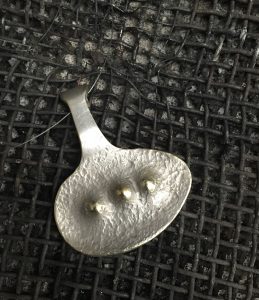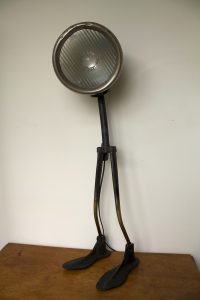Upcycling, to me, is not new; it’s not a trend, or a fad. It’s a way of life. Working as MCMDesign, I have been repurposing and using reclaimed materials wherever possible in furniture, jewelry and building projects for the better part of three decades. Upcycling has made my design practice sustainable: I don’t have the worry of environmental footprints.
My works are all handcrafted. A lengthy and diverse working life means that I can confidently interact with tools and materials. Experimenting is important. Once you become proficient with using tools, you can take it to the next level and make your own tools. And then what you create becomes truly original – although sometimes there’s a problem when making the tool takes longer than completing the task for which its being made! Take the pendants that I create from vintage spoons, for example. I made a punch (tool) for pressing a particular shape into them, this adds another dimension: the pattern on this unique handcrafted object (the spoon) also acts as a kind of imprint of a unique handcrafted object (the tool). Also the tools are usually made by repurposing, then another upcycling dimension is added to the finished creation.

I generally use material from items greater than 50 years old when only the best raw materials were sourced by industry. They have a standard and character that’s not being repeated and it is their superior quality that enables me to give them new life, decades after they were first created. I’ve also worked with material more than 5000 years old. For example, I made a key ring from a sliver of preserved River Redgum, sourced from the Murray Darling region in the mid-1990’s. It’s precious material and I wanted to create something that would respect its history and also be meaningful on a personal level – I have been carrying this key ring in my pocket for well over a decade!
I try to breathe new life into objects that would otherwise be discarded or replaced. Sometimes I refurbish an object. In my opinion full restoration for its own sake is often ridiculous. Stripping away the history and character of anything can take a huge amount of time, effort and energy: all for the sake of possessing something, declaring ownership of it. Unless something is incredibly rare and obsolete, restoration is not necessarily the only way to give any item an extended life.
Upcycling means making a judgement, looking at an object and being able to see when the whole thing should be restored or if its just more effective to repurpose parts of it. Upcycling respects the original but also allows for the original to take on a new context, and to actually be useful. This is why I often create lamps like Alfi, which is assembled from a 1927 Dodge Brothers headlamp; a fork from a vintage bike and shoe lathes.

When I create something, I don’t just pay attention to the aesthetic aspects of the objects and materials. With three decades of experience in the furniture and manufacturing industries, I know their original social and historical contexts. With Alfi, the head lamp and the fork are from a different social and industrial period, when transportation involved cycling and Fordist industrial modes of automobile production. While its important to me that Alfi is a lamp and a useful object that creates light, he also tell us something about the history of transportation. I want my creations to invite conversations: about their historical contexts – why they were manufactured, and what they were designed for… and I think about the future, too. A future where every thing and material is seen as valuable and rarely ends up in landfill.
